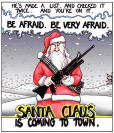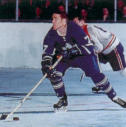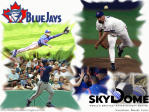Happy holidays .. and hockey blight in Canada
Dec 17th, 2004 | By Dominic Berry | Category: Sporting Life The National Hockey League is the one half-serious example of Canadian cultural imperialism extant. So when the front page of Canada’s national newspaper moans “NO DEAL, NO TALKS, NO HOCKEY,” on December 15, you know something is half-seriously amiss at the north pole.
The National Hockey League is the one half-serious example of Canadian cultural imperialism extant. So when the front page of Canada’s national newspaper moans “NO DEAL, NO TALKS, NO HOCKEY,” on December 15, you know something is half-seriously amiss at the north pole.
As far as what is to be done practically goes, only fools will rush in. The technical details of the dispute between the not-rich-enough owners and the a-lot-richer-than-most-of-us players are best left to those with the latest statistics, press releases, and unrevealable sources close at hand.
 For the older plain citizens who once swooned to “Hello Canada, and hockey fans in the United States” on the radio, every Saturday night from October to April, what really matters is the existential angst about the future of Canadian culture.
For the older plain citizens who once swooned to “Hello Canada, and hockey fans in the United States” on the radio, every Saturday night from October to April, what really matters is the existential angst about the future of Canadian culture.
Hockey is the only thing that Canada has ever become truly famous for anywhere in the world, including the United States. Now that it seems almost certain there will be no NHL hockey at all for the 20042005 season, many Canadians have begun to think that there will be no Canada either. Some parts of the country are starting to get almost seriously concerned.
 Or are they? A December 10 poll in the online edition of the Globe and Mail asked “Would you be particularly troubled if NHL hockey never came back?” Only 29% of more than 21,000 voters answered Yes.
Or are they? A December 10 poll in the online edition of the Globe and Mail asked “Would you be particularly troubled if NHL hockey never came back?” Only 29% of more than 21,000 voters answered Yes.
As other such evidence regularly makes clear, the online readers of Canada’s national newspaper are far from a random sample of the national population, in both official languages or otherwise. Yet even so the 71% of them who don’t care whether the NHL ever returns defy much traditional wisdom about the passion for professional hockey in the good old great white north.
 Some will point out that, just for starters, the NHL itself has changed a lot from the days of what are mistakenly called the “Original Six,” back in the 1950s. But the Original Six were themselves just the remnant of a once larger NHL that went back to the 1920s (and included such exotic teams as the New York Americans and the Montreal Maroons).
Some will point out that, just for starters, the NHL itself has changed a lot from the days of what are mistakenly called the “Original Six,” back in the 1950s. But the Original Six were themselves just the remnant of a once larger NHL that went back to the 1920s (and included such exotic teams as the New York Americans and the Montreal Maroons).
Those who know about such things seem to be saying that when today’s NHL finally does get back to business, it too will almost certainly have fewer teams than it does now. Or the more things change, the more they stay the same – as they say (and usually in French of course) in the great Canadian hockey province of Quebec, home of Maurice “Rocket” Richard, Jean Beliveau, Jacques Plante, Yvan Cournoyer, Guy LaFleur, Mario Lemieux, and on and on and on. (And the Western Canadian anglophone mass affection for Rocket Richard when he marched in the Calgary Stampede parade every year probably has a certain amount to do with Quebec’s continuing inability to exactly leave Canada, despite everything else.)
 Those of us who grew up trading hockey cards in the 1950s will also remember that, even then, there was some confusion about exactly what nation was being referred to in the name of the National Hockey League. In the lexicon of the early 21st century the six-team 19421967 version of the NHL was a kind of United States of Canada blue-state league – with teams in New York, Boston, Detroit, Chicago, Toronto, and Montreal.
Those of us who grew up trading hockey cards in the 1950s will also remember that, even then, there was some confusion about exactly what nation was being referred to in the name of the National Hockey League. In the lexicon of the early 21st century the six-team 19421967 version of the NHL was a kind of United States of Canada blue-state league – with teams in New York, Boston, Detroit, Chicago, Toronto, and Montreal.
At the same time (and as all young hockey-card traders knew, from the succinct data on the back of the cards), in those days almost all NHL players had been born in Canada. My own memory is that in the mid 1950s there were only two US-born players in the league. Four of the original six teams were based in US cities, but the NHL was still our league in Canada. Without us, it would have no players. And, besides, over the 25 original-six seasons from 194243 to 196667 the Stanley Cup was won 19 times by either the Montreal Canadiens or the Toronto Maple Leafs.
 The not-so-original original-six NHL began to expand in 1967 – the centennial year of the Canadian confederation (and the year of the Montreal Expo world’s fair, with Pierre Trudeau already a cabinet minister in Ottawa, just waiting to become prime minister in 1968). Its subsequent journey has wrought some remarkable transformations.
The not-so-original original-six NHL began to expand in 1967 – the centennial year of the Canadian confederation (and the year of the Montreal Expo world’s fair, with Pierre Trudeau already a cabinet minister in Ottawa, just waiting to become prime minister in 1968). Its subsequent journey has wrought some remarkable transformations.
Even in 1970 98% of all NHL players had been born in Canada. But by the time of the 1982 Stanley Cup (won by the New York Islanders) the number had slipped to 82% (with 10% born in the USA, and 8% in other countries). By 1992 (when the Cup was won by the Pittsburgh Penguins) it was 71% born in Canada, 17% in the US, and 12% in other countries. By 2002, with the original-six Detroit Red Wings back in the Stanley Cup business, only 52% of all NHL players were born in Canada, 14% in the US, and 34% in other countries (in the colder more northerly parts of the globe of course, with Russia as a leading example).
![]() As Sports Illustrated in the US explained the season before last, in the NHL today “players from 23 countries … comprise the most international and diverse talent pool in pro sports.” And this perhaps somehow reflects Canada’s continuing closer proximity to its more ancient history as an official part of the old British and French global villages in America.
As Sports Illustrated in the US explained the season before last, in the NHL today “players from 23 countries … comprise the most international and diverse talent pool in pro sports.” And this perhaps somehow reflects Canada’s continuing closer proximity to its more ancient history as an official part of the old British and French global villages in America.
Yet, as diverse as it may be in other respects, hockey is also still widely perceived as the North American sporting world’s last great bastion of the white man. Some time ago now, on US TV, Arsenio Hall asked Wayne Gretzky:”Why are there no black players in the NHL, man?” Wayne’s answer was that they were coming.
 By 2003 there were “13 black athletes” among “the 600+ players in the NHL today.” According to Michael Morrison and Chris Frantz: “While racism certainly played some role in keeping the figure to a minimum, it may have been more a function of the demographic makeup of Canada. In 1971, Canadians made up over 95% of the NHL, and only .02% of all Canadians were black. Today, the black population in Canada has increased to 2%.” (Riding the subway in a place like Toronto today, it is hard to believe that the black population of Canada is still as low as 2%. But perhaps in this as in other respects Toronto is not an exact microcosm of Canada at large.)
By 2003 there were “13 black athletes” among “the 600+ players in the NHL today.” According to Michael Morrison and Chris Frantz: “While racism certainly played some role in keeping the figure to a minimum, it may have been more a function of the demographic makeup of Canada. In 1971, Canadians made up over 95% of the NHL, and only .02% of all Canadians were black. Today, the black population in Canada has increased to 2%.” (Riding the subway in a place like Toronto today, it is hard to believe that the black population of Canada is still as low as 2%. But perhaps in this as in other respects Toronto is not an exact microcosm of Canada at large.)
Wayne Gretzky himself – and the five Stanley Cups he helped the Edmonton Oilers win in the 1980s – is the greatest Canadian story in the more recent history of the NHL. (Then Wayne went to Hollywood, to marry a starlet and play for the Los Angeles Kings, but that is another kind of Canadian story.) The second greatest is the 10 Stanley Cups that the Montreal Candiens have still managed to win, since the original expansion of the not-so-original original six in 1967 (though the last of these was more than a decade ago now).
 The NHL that is still not playing in the 2004-2005 season has 30 teams, six of which now represent Canadian cities (Montreal, Ottawa, Toronto, Calgary, Edmonton, and Vancouver) – conceivably a new original six for some future generation, and twice as many as Canada’s share of the combined US-Canada population would suggest.
The NHL that is still not playing in the 2004-2005 season has 30 teams, six of which now represent Canadian cities (Montreal, Ottawa, Toronto, Calgary, Edmonton, and Vancouver) – conceivably a new original six for some future generation, and twice as many as Canada’s share of the combined US-Canada population would suggest.
Just over a bare majority of all NHL players are still born in Canada. And the majority includes one of the league’s current leading black players, Anson Carter, who comes from the Toronto inner suburb of Scarborough, like the Canadian Hollywood comedian Mike Myers. (And why the current management of the Toronto Maple Leafs does not have the imagination to ensure that Carter plays on his hometown team is another good question for Torontonians.)
 Canada itself has changed a great deal since 1967. And it is no doubt hardly surprising that hockey should change with it. Wayne Gretzky is perhaps still a better model for the early 21st century northern North American country that declined to put troops on the ground in Iraq, etc., than such more ancient hockey legends as Rocket Richard and Gordie Howe – to say nothing of Howie Morenz or King Clancy or the immortal Babe Dye.
Canada itself has changed a great deal since 1967. And it is no doubt hardly surprising that hockey should change with it. Wayne Gretzky is perhaps still a better model for the early 21st century northern North American country that declined to put troops on the ground in Iraq, etc., than such more ancient hockey legends as Rocket Richard and Gordie Howe – to say nothing of Howie Morenz or King Clancy or the immortal Babe Dye.
The great Gretzky, as Bert Reynolds once explained to Johnny Carson on US TV, looked “like Bambi.” But when you watched him get around all the big tough guys on the ice you were nonetheless dazzled. (Canada at large itself, of course, is still some considerable distance from actually living up to this Gretzky ideal, but at least the model is there.)
 In any case, in 2005 both the NHL owners and the NHL players might want to pay some particular attention to the Globe and Mail‘s December 10, 2004 online poll, which showed that 71% of the readers of Canada’s national newspaper just don’t care whether they ever come back. Hockey is still no doubt Canada’s national sport. But maybe the ultimate point is just that even half-serious countries just don’t need national sports nowadays, the way they used to.
In any case, in 2005 both the NHL owners and the NHL players might want to pay some particular attention to the Globe and Mail‘s December 10, 2004 online poll, which showed that 71% of the readers of Canada’s national newspaper just don’t care whether they ever come back. Hockey is still no doubt Canada’s national sport. But maybe the ultimate point is just that even half-serious countries just don’t need national sports nowadays, the way they used to.
(The United States itself, e.g., does not really have a national sport any more – now that football has become more popular than baseball. And among other things, the Toronto Blue Jays have now won the World Series twice, which, according to the testimony of assorted US TV gurus at the time, sort of put the finishing touches on baseball as America’s national sport, even though a great many of the Blue Jays championship players were of course born in the USA.)
 Meanwhile, Brett Hull, a present-day National Hockey League star who was born in Canada, just like his father, recently appeared on the US TV show Saturday Night Live. (Like other NHL players he has some time on his hands at the moment.) He was asked about the current political struggle in Ottawa to legalize gay marriage right across the true north, strong and free. “That’s what happens in Canada when there’s no hockey,” he said. “Guys have more time to hang out, talk about their feelings and fall in love with each other. I have nothing against it, but I’d rather be playing hockey.”
Meanwhile, Brett Hull, a present-day National Hockey League star who was born in Canada, just like his father, recently appeared on the US TV show Saturday Night Live. (Like other NHL players he has some time on his hands at the moment.) He was asked about the current political struggle in Ottawa to legalize gay marriage right across the true north, strong and free. “That’s what happens in Canada when there’s no hockey,” he said. “Guys have more time to hang out, talk about their feelings and fall in love with each other. I have nothing against it, but I’d rather be playing hockey.”
Canadian culture is at least continuing to make some progress, it seems, on Gretzky’s new Bambi ideal. (Though Brett Hull himself, who plays for the Phoenix Coyotes these days, still looks more like Gordie Howe.)

